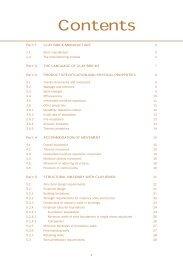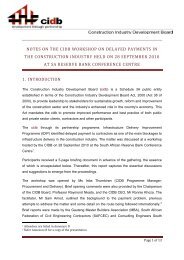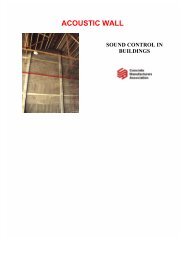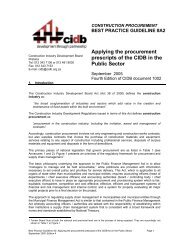MANUAL 4 - Construction Industry Development Board
MANUAL 4 - Construction Industry Development Board
MANUAL 4 - Construction Industry Development Board
Create successful ePaper yourself
Turn your PDF publications into a flip-book with our unique Google optimized e-Paper software.
<strong>MANUAL</strong> 4 – BITUMINOUS PAVEMENT SEALS<br />
• Lightly water the surface, using a sprinkler nozzle on the hose and place the screed<br />
box on the rails (if one is being used).<br />
• Place shovels of the slurry just ahead of the screed, in sufficient quantities for the<br />
squeegee operators to spread the material sufficiently thick, for the screed to level the<br />
surface quickly and efficiently. Placing too much slurry too close to the screed, makes<br />
the screed and squeegee operators’ work more time consuming.<br />
• During the process of shovelling the slurry from the barrow to the road, the shovels<br />
must be dipped into the drum of water and wiped with a wet mutton cloth.<br />
Note<br />
Occasionally the last barrow loads of slurry from the mixer are drier than the first loads<br />
and just too dry to spread efficiently. Before discharging the load, it is advisable to return<br />
the load to the mixer where a limited amount of water can be added and remixed to<br />
correct consistency.<br />
• If some of the load has already been discharged on the road, a light sprinkle of water<br />
can be applied to assist in efficient spreading.<br />
• Note that all the hand tools, if continuously cleaned in the ½ drum of water next to<br />
the work area, the operation proceeds more efficiently. Instead of using ½ drum of<br />
water, a wheelbarrow of water will be more efficient. It can be moved as the work<br />
progresses.<br />
• A stable grade Anionic emulsion will take anything from two to three hours for initial<br />
breaking of the emulsion to occur, depending on the humidity and temperature<br />
prevailing on site. Therefore, if wet weather is predicted and imminent, no slurry work<br />
must be attempted.<br />
• No traffic must be allowed to use the surface until the emulsion has broken and set.<br />
• No slurry must be placed on a dry surface. It is essential to ensure that adequate<br />
watering facilities are in place before the work starts.<br />
• Cleanliness of equipment is advisable at all times and the due care of the rails, when<br />
storing and handling, is essential to prevent the rails being damaged or bent.<br />
• Cleanliness in and about the work site is essential to ensure no free bitumen is carried<br />
onto the work by pedestrians or the work’s team.<br />
• Once a mix is commenced, there must be no stoppage of the work e.g. lunch breaks,<br />
etc., until the cycle of mixing and laying of the mix has been completed.<br />
• The screed operators must be replaced every hour to allow them to do less arduous<br />
work for at least an hour.<br />
IMPLEMENTING EMPLOYMENT INTENSIVE ROAD WORKS 47<br />
MODULE<br />
1<br />
2<br />
3<br />
4<br />
5<br />
6<br />
7












